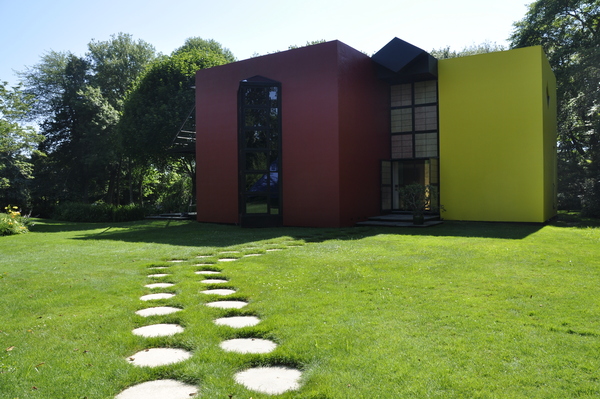
Hamptons style. It is in high demand from many consumers, though defining the concept can leave some scratching their head. They recognize it when they see it, yet are unable to explain what exactly it is.
But three industry professionals—architect Harry Bates, interior designer Kerry Delrose and landscape architect Craig James Socia—will attempt to make sense of it all during a design symposium before St. Ann’s 43rd annual house tour on Thursday, August 4.
“It’s about what Hamptons style is today, and what that means,” said interior designer and Press News Group’s “Interiors by Design” columnist Marshall Watson, who conceived of and is moderating the second annual symposium. “I initially thought that St. Ann’s has always had a fabulous house tour. I felt it could be of interest to people coming on the tour to be stimulated with questions about design before seeing these incredible places.”
This year’s tour will feature the Ludlow Grange house—a saltbox built in 1820 by Captain Isaac Ludlow in Bridgehampton and expanded into a traditional Victorian style in the 1880s; a classic Sagaponack farmhouse that will feature a collection of old farm implements and Early American quilts; and architect Preston Phillips’s modern Bridgehampton home, which has graced the cover of Architectural Digest.
“It’s a cross-section of different eras and different styles of architecture,” said St. Ann’s house tour chair Elizabeth George. “People come for inspiration, to see things they’d never be able to do in their own homes. It’s a kind of vicarious escape. It’s an opportunity to step back into a different era or experience a new environment that stimulates all the senses.”
The colorful geometric symbols painted on the threshold of Mr. Phillips’s lengthy driveway serve as a welcome mat to what lies at its end: a 2,800-square-foot modern home based in the De Stijl movement of Europe in the early 20th century, which focuses on geometry and primary colors.
“So everything has a geometric basis and then the colors were employed very much in keeping with the guidelines of the era,” Mr. Phillips, who spoke during the inaugural design symposium last year, explained. “Everything down to the pool is a geometric form. It’s quite exhilarating. It’s a very modest house but there’s a lot of design energy in it.”
Mr. Phillips built his red and yellow home in 1988 after falling in love with the north-of-the-highway farms, fields and forests, he recalled during a telephone interview last week. Soon after came his architectural studio, constructed in the shape of a pyramid.
“I wanted the approach to be a surprise,” he said. “It’s a rather long driveway, and the house emerges at the end of it. It’s out of sight and suddenly, there it is. The interior is all about interlocking space that connects to the second floor, and views through other rooms to the exterior. It’s very three-dimensional.”
Sixty years ago, the Hamptons were the breeding grounds for modern architecture, Mr. Bates, who will speak about architecture during the symposium, said during a telephone interview last week.
“Then it went the other way, and now it’s going back. Well, I hope it’s going back, back to the modern,” he said. “I’m a modernist. I haven’t done other things, the so-called McMansions.”
Mr. Bates said he doesn’t see a predominant Hamptons style other than pure simplicity.
“It’s a word I don’t use often—style—but that’s not to say it shouldn’t be used,” he mused. “I think that just goes back to when I started, a long time ago. I think people are trying to make things simpler. There’s nothing superfluous. That’s our business, but then again, you’ll get a different answer from an interior designer.”
For Mr. Watson, style on the East End is cutting-edge-fashion-meets-comfortable-casual, with a certain chic quality.
“Why are there so many trashy reality shows about the Hamptons?” he asked with a laugh. “Why is it that the Hamptons have a magical ring across the country? It’s because when magazines are publishing things, the Hamptons are the first to be noticed. There’s a hushed awe about people who live in the Hamptons.”
With the recession and sustainability on the tip of everyone’s tongue, Mr. Watson said he expects the symposium conversation will shift toward its effect on building and planting materials, and trends in arenas like color, fabric, furniture and the antique market.
The take-away from the symposium is simple, Mr. Watson said.
“You’ll take away visual inspiration. You’ll take away reasons why they’re designing this way in the Hamptons today,” Mr. Marshall said. “It will help when designing your own homes while trying to bring them into harmony with the Hamptons environment.”
St. Ann’s will host its 43rd annual house tour on Thursday, August 4, from 1:30 to 4:30 p.m. A design symposium will be held at the Silas Marder Gallery in Bridgehampton from 11:30 a.m. to 1 p.m. that day. The event is sponsored by The Southampton Press. Admission to the tour or symposium is $50, or $75 for both. Proceeds will benefit a variety of local charities. For tickets or more information, call 537-1527 or visit bhhousetour.com.